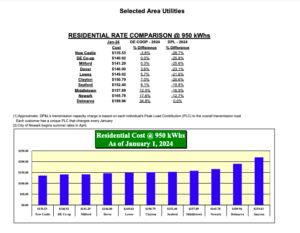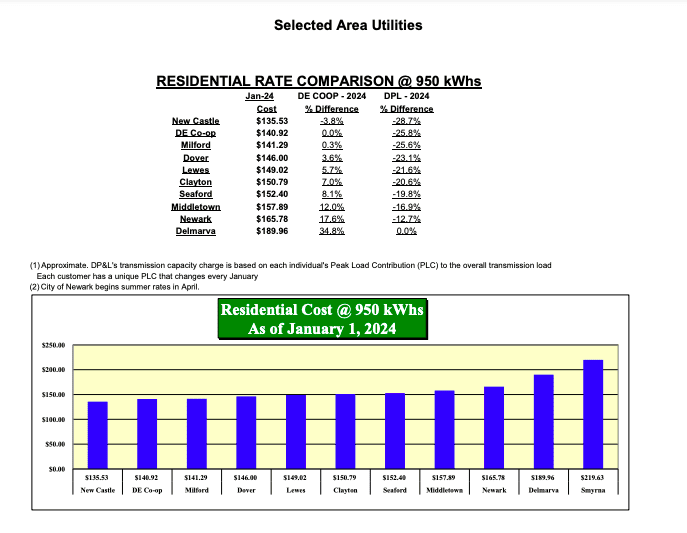

A chart provided by City Manager Mark Whitfield showing that Milford’s electric rate is the third lowest in the area
Recently, the City of Milford announced that electric rates would be increasing due to an increase passed on to the city by the Delaware Municipal Electric Corporation (DEMEC). This organization is a not-for-profit entity made up of eight municipalities that offer their own electric service, including Milford.
“DEMEC has professional staff that is responsible for purchasing power as well as planning for the future,” Mark Whitfield, Milford City Manager, said. “They are a joint action agency that represents the interests of all eight cities at the state and federal level for fair and equitable regulations for power suppliers.”
Last year, DEMEC announced that it would have to increase rates charged to the municipalities in part due to the shutdown of the Indian River Power Plant. Although Milford did not purchase power from that plant, the shutdown substantially increased transmission and congestion costs, according to Whitfield.
“These costs are billed to DEMEC through PJM, the regional transmission organization that coordinates the movement of wholesale electricity,” Whitfield said. “Energy charges to DEMEC increased more than five percent. Renewable energy requirements also increased by nine percent. Lastly, to keep rates stable throughout the year, DEMEC uses a rate stabilization fund. Based on actuarial study that included power system costs, an increase was needed to adequately fund the reserve account over the next five years.”
Many people believe that the City of Milford has excessively high electric rates and often question when the city releases information that they are the third lowest in the state. The fact is that the city of Milford does have much lower rates than other municipalities and the Delaware Electric Co-op.
“The average, and I stress average, City of Milford resident uses 950 kwh per month,” Whitfield explained. Based on that usage, our rates are within one-half percent of the Co-Op and significantly lower than Delmarva Power, the only providers of electricity in the 19963 zip code. Depending on usage and how each entity bills, customers who use more than the average may have a higher Milford bill than the co-op or other utilities because of the way they tier their charges. We have tried to keep our bills simple with a flat usage fee for both summer and winter. Many utilities have a much higher “summer” rate, so Milford’s rate usually looks better in comparison in the summer than in the winter.”
Based on a chart provided by Whitfield, New Castle and the Co-Op are the only two electric providers with lower rates than Milford. A New Castle customer using the average 950 kwh would pay $135.53 for their January 2024 bill while Co-Op customers pay an average of $140.92, compared to $141.29 for Milford customers. Looking at rates higher than Milford for the same 950 kwh, Dover customers would pay $146.00, Lewes $149.02, Clayton $150.79, Seaford, $152.40, Middletown $157.89, Newark $165.78 and DP&L $189.96.
“When comparing electric usage and rates, City residents also need to look at the electric portion of their utility bill,” Whitfield said. “We have found that many folks compare their overall utility bill, which includes water, sewer, trash and recycling, to that of out-of-city resident bills that are electric only. Electric is just one portion of their monthly utility bill.”
Whitfield explained that the city recently transferred $3.25 million from the electric fund to the General Fund in 2024.
“This transfer sharply reduces property taxes and funds various general fund activities, such as police and public safety, planning, administration, streets, community festivals and parks and recreation,” Whitfield said. “Neighboring cities that do not have an electric utility, do not receive money from the electric utility serving the community, which leads to higher taxes and user fees for those communities. There is a huge advantage to consumers to be served by a municipal non-profit electric company, including reliability, lower taxes and lower electric rates while providing excellent police and public service amenities.”
Whitfield stated that most of the information for each utility can be pulled from the utility website, allowing anyone to do the calculation he provided in the chart.
Share this Post



